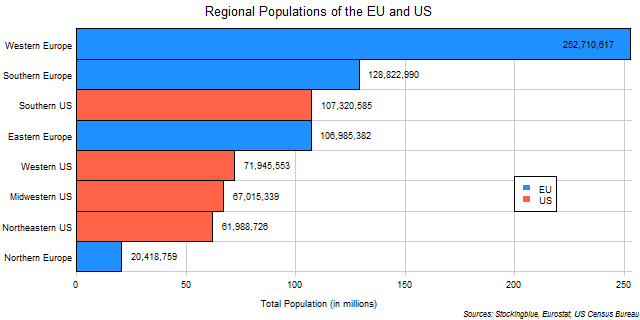
The chart above shows the regional populations of the European Union and the United States. There is a large disparity of population in European regions whereas the population differences are not all that great between American regions.
Findings
- The difference between the most populous region in the EU and the least populous is 232,291,858 people.
- The difference between the most populous region in the US and the least populous is 45,331,859 people.
- The most populous EU region is 12.38 times more populous than the least populous EU region.
- The most populous US region is 1.73 times more populous than the least populous US region.
Caveats
- The data is from 2010.
- EU and US data come from two different sources.
- Western Europe consists of Germany, United Kingdom, France, Netherlands, Belgium, Austria, Ireland, and Luxembourg.
- Southern Europe consists of Italy, Spain, Portugal, Greece, Cyprus, and Malta.
- The Southern US consists of Texas, Florida, Georgia, North Carolina, Virginia, Tennessee, Louisiana, South Carolina, Alabama, Kentucky, Oklahoma, Arkansas, Mississippi, and West Virginia.
- Eastern Europe consists of Poland, Czech Republic, Romania, Hungary, Slovakia, Bulgaria, Croatia, Slovenia, Lithuania, Latvia, and Estonia.
- The Western US consists of California, Washington, Colorado, Arizona, Oregon, Utah, Nevada, New Mexico, Hawaii, Idaho, Alaska, Montana, and Wyoming.
- The Midwestern US consists of Illinois, Ohio, Michigan, Indiana, Minnesota, Wisconsin, Missouri, Iowa, Kansas, Nebraska, North Dakota, and South Dakota.
- The Northeastern US consists of New York, Pennsylvania, New Jersey, Massachusetts, Maryland, Connecticut, New Hampshire, Delaware, Maine, Rhode Island, and Vermont.
- Northern Europe consists of Sweden, Denmark, and Finland.
Details
In both the EU and the US, the most populous regions just need one more region to obtain a majority of the superstate's population. Only the South in the US and Western Europe need just one more region to obtain a majority. All other regions need two more regions to form a majority population (unless they are forming it with the largest region). One can see how the politics of both the EU and the US tend to favor policies that people in the larger regions prefer.
If the United Kingdom leaves the EU, then Western Europe's population falls to 187,857,224. This would allow Southern and Eastern Europe to form a majority without a third region. So, Southern and Eastern European states will get to have more of a say in EU politics assuming their interests are aligned. It really is Western Europe that has the most to lose from the UK exiting the Union as other regions could form a majority much easier. Not that the UK's interests are always more aligned with the rest of Western Europe but they are closer than the interests of other regional blocs. It should be interesting to see how EU policies and regulations change as a result of this and how much more influence Southern and Eastern Europe will have in the shaping of those decisions.
Sources
Eurostat. 2017. "Data Explorer." Accessed December 11, 2017. http://appsso.eurostat.ec.europa.eu/nui/show.do?dataset=urb_lpop1&lang=en.
United States Census Bureau. "Annual Estimates of the Resident Population: April 1, 2010 to July 1, 2016." Accessed December 12, 2017. http://factfinder2.census.gov.